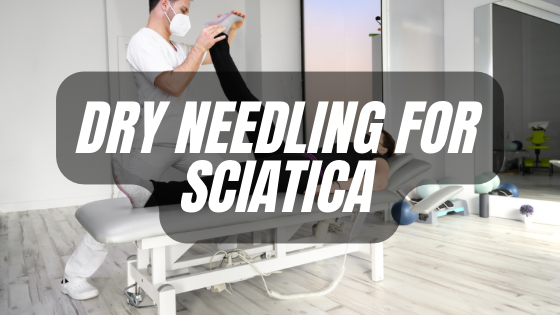Sciatica is a type of nerve pain that can be very debilitating. If you are one of the millions of people who suffer from this condition, you know how frustrating and painful it can be.
There are many treatments available for sciatica, but some people find that they don’t respond well to traditional treatments like physical therapy and cortisone injections. The good news is there’s a different option called dry needling that is specifically designed to help treat pain, and can especially help sciatica.
What is dry needling and how does it work
Dry needling is a highly effective treatment technique that uses fine acupuncture needles to stimulate the healing and repair of highly sensitive muscle, fascia fibers and irritated nerves that are causing pain. Injury and irritation to muscle and connective tissue is the most common cause and contributor to pain but it is unfortunately overlooked by the vast majority of doctors treating pain.
Dry needlig gently stimulates the highly reactive fibers, or trigger points, along with surrounding tissue, often eliciting a “light twitch” (reflex) response and provoking the sensitive fibers to respond by protecting and repairing themselves.
What are the Benefits of dry needling for Sciatica
Dry needling can provide a number of benefits for those who suffer from sciatica.
Some of the key benefits include:
- Relief from chronic pain that doesn’t respond well to other treatments
- Reduction in muscle tension and spasms
- Improvement in range of motion and mobility
- Accelerated healing of injured tissue
- Reduction in the need for medications
- Reduction in the need for surgery
The first step is for us to find your pain generators
Surprisingly all pain that goes down your leg IS NOT sciatica. There are a bunch of other structures and tissues that can mimic sciatic pain. So our first step is to perform a thorough physical exam and check every single structure that could be causing your discomfort. There are quite a few things that can mimic sciatica and that are missed if your doctor just ordered an MRI but didn’t correlate those findings with a thorough hands on physical exam.
Here’s what my physical exam looks like when you come to me for back pain or sciatica:
Palpation
- L1-S1 Facet Joints
- Erector Muscle Group from T10-L5
- Multifidus from L1-L5
- Spinous process L1-L5
- Superior Cluneal Nerve at T10-L2 and above PSIS
- Quadratus Lumborum
- SI joint / Medial Cluneal Nerve
- Greater trochanter
- Glute muscles (max,med, min)
- Deep 6 hip rotators (piriformis, etc)
- Ischial tuberosity
- Ligaments in low back (illiolumbar, posterior sacroiliac, sacrotuberous)
Range of Motion
- Flexion
- Extension
- Lateral / Side Bending
- Hip Internal ROM
- Hip External ROM
Provocative Tests
- Straight Leg Raise
- Hip FABER-Flexion abduction external rotation
This means palpating your back muscles, facet joints, SI joint, SI ligaments, the illiolumbar ligament, all of your glute muscles, the deep rotators of your hip, the sciatic nerve itself at multiple potential entrapment sites and all of the connective tissue in between.
The physical exam is a lost art, especially when it comes to manual medicine and orthopedic conditions. I’ve found that a good hands on physical exam can help me to pinpoint where the vast majority of peoples pain conditions start and end.
So while you might have true sciatica, it’s actually more likely that there is another issue causing your sciatic like symptoms than true sciatica.
Using Dry Needling & Neurofunctional Acupuncture to treat sciatica & the problems that mimic sciatica
When it comes down to the nitty gritty, acupuncture & dry needling fall into the same category of using a needle to elicit some kind of tissue change. The techniques between the two are different so it’s best to know how to use both approaches. Because dry needling is excellent for purely muscular issues. When there is an irritated nerve involved, it can be extremely helpful to use techniques from Neurofunctional acupuncture along with dry needling. This is why your treatments with Dr. Josh Hanson, DACM are so comprehensive.
When we dive into the research, there is far more literature on acupuncture’s effect on neuropathic pain (sciatic like pain).
An article in the Journal of Clinical Medicine by Perreault et al. in 2021 titled, Needling Interventions for Sciatica: Choosing Methods Based on Neuropathic Pain Mechanisms-A Scoping Review (1), states “Current evidence supports the efficacy and effectiveness of acupuncture for sciatica”.
In a smaller scale rct performed in 2021, the author compared 2 types of acupuncture against each other. They both had an incredibly high effectiveness rate for sciatic truck pain. In the study for pain coming from the sciatic trunk, acupuncture had an effectiveness rate between 78.6% to 92.9% (2)
The key is to find a practitioner who is highly skilled in manual medicine and needling techniques.
How many dry needling treatments will I need to treat sciatica?
The truth is that this number is going to be different for everyone and I can’t tell you a specific number without performing a physical exam. Even then, I can only give you a range based off my clinical experience.
There are so many factors that determine this. Like..
- How long have you had the pain / discomfort?
- What is your overall health?
- How adaptable is your nervous system?
- What is your day to day life like – what repetitive motions, sustained postures, and movements do you perform that could stress / load your injured tissues?
- What have you tried that has worked / hasn’t worked?
- What medications do you take on a regular basis?
The answered to these questions and what we find on your physical exam will play into your healing capacity.
Expect weekly treatments for a period of time (4-12 weeks) as a good starting point. There is no magic treatment to cure you of your pain in one visit, the body just doesn’t work that way.
How to find a qualified practitioner
When it comes to finding the best dry needling near you, you need to first and foremost look for a practitioner with experience and who’s sole job is to use a needle to elicit change in the body. In Florida both Acupuncturist and Physical Therapist can provide dry needling.
The difference is the amount of training and experience these two types of practitioners have with sticking needles in people. Dr. Josh Hanson, DACM is by far one of the most experienced dry needling practitioners in the state of Florida – having performed well north of 35,000 dry needling procedures over the past decade.
As an acupuncturist my only job is to needling patients all day every day. We spend over 3000 hours in school before we can needle a patient. On top of that, I’ve been seeing 15-20 patients a day for years. There’s literally no way a physical therapist with a very short weekend course could accumulate the experience I have in the short 2 years they have been allowed to perform dry needling in Florida.
For a physical therapist to get certified in dry needling they only have to take a very short weekend course (~30 hours) then they are allowed to stick needles in people. They only learn a very small list of muscles and because of this their skill level will be a very basic level for quite some time. If you’re lucky they will treat a couple of patients a day with needling, while they do all of the other modalities they use.
So find a practitioner who has the specialized training like Dr. Josh Hanson, DACM and the experience to use that specialized training. The techniques necessary to treat sciatica with dry needling are on the more advanced end of the treatment spectrum.
If you’re in Tampa, FL and searching for dry needling for sciatica, then don’t hesitate to reach out!
References:
1) Perreault T, Fernández-de-Las-Peñas C, Cummings M, Gendron BC. Needling Interventions for Sciatica: Choosing Methods Based on Neuropathic Pain Mechanisms-A Scoping Review. J Clin Med. 2021 May 19;10(10):2189. doi: 10.3390/jcm10102189. PMID: 34069357; PMCID: PMC8158699.
2) Huo J, Zhao JQ. [Triple needling combined with thermo-electroacupuncture at Huantiao (GB 30) for trunk-sciatica]. Zhongguo Zhen Jiu. 2021 Mar 12;41(3):275-8. Chinese. doi: 10.13703/j.0255-2930.20200210-k0003. PMID: 33798309.


